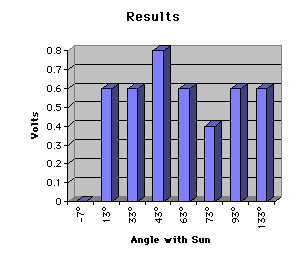Attribution: This is a cached copy of a third party project. Many of these sites are from 20 years ago and the majority are no longer running. We show only the first page of the project. We do not save all pages since copyright belongs to the third-party author.
Timber Ridge Virtual Science Fair

by Matt C-G
Click on the image to get a full screen view

 Back
to the top of the page.
Back
to the top of the page. 
by Matt C-G
| I
think that if the solar cell is placed perpendicular to the sun's rays,
the
power going to the cell will be maximized. |
|
|
When I was assigned this project, I decided to investigate whether solar
power was really a feasible alternative to other sources of energy.
I wanted to see if solar power could be used to charge batteries for other
purposes, or to heat water, or operate machinery. As I considered
these options, I wondered how I could maximize the efficiency of the sun
and its rays. So, I decided this could be my experiment. So,
the purpose of my experiment was to find the best way to maximize the efficiency
of solar power.
Once I had decided the purpose of my experiment, the next step was to formulate my hypothesis and choose how to test it in my experiment. My hypothesis then became, "If the sun is at a 90° angle with the solar cell, the amount of voltage received will be greater than if the sun is at any other angle with the solar cell." To then test this hypothesis, I created a set-up that allowed me to measure the voltage going to a solar cell when the sun was placed at different angles to the cell. When I finished conducting the experiment, I examined the data I had collected. I found that with my set-up, my hypothesis had not been correct. With the cell at a right angle to the ground, the energy was 4/5 volts. When it was at a right angle to the sun, however, it measured 3/5 volts. At other angles, it measured from 0 to 4/5 volts. Given this data, my conclusion is that my hypothesis is not accurate, and if I ever build a full scale solar cell, I will move the solar cell so that it is at right angles to the ground. |
|
|
|
|
|
|
Results
|
My results are listed in the table below. |
| I think the results of my experiment arenít logical. My hypothesis was that if the cell was perpendicular to the sun, the voltage would be maximized. The results, however, showed that when the cell was perpendicular to the ground, the voltage was maximized. Either my hypothesis had been false, or my experiment had been flawed. Itís not obvious, however, which of the two is true. The experiment could be improved by conducting it several different times on several days. It would have made my experiment more accurate by providing more results from which I could then compare. Even though my experiment proved my hypothesis wrong, it did prove that different angles collect different amounts of electricity. | |
|
| Angle with Ground | Angle with Sun | Voltage |
| 40° | -7° | 0 |
| 60° | 13° | 3/5 |
| 70° | 33° | 3/5 |
| 90° | 43° | 4/5 |
| 110° | 63° | 3/5 |
| 120° | 73° | 2/5 |
| 140° | 93° | 3/5 |
| 180° | 133° | 3/5 |
Matt C-G
Timber Ridge Magnet School
